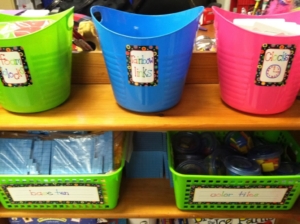As teachers, we know that manipulatives are vital to helping students develop an understanding of new concepts. We also know that student misuse of manipulatives can easily stress us out. To avoid the feeling of wanting all manipulatives to disappear forever, follow this guide to make them effective for your class!
Organize manipulatives in a way that works best for you and your students:
• Manipulatives should be easily accessible to students.
• Separate different types of manipulatives into different baggies or containers.
• Think about the manipulatives that will be useful for almost all content areas throughout the year. Those tools could be in storage bins or drawers at the students’ desks.
• When starting a new concept, include any other tools that would be helpful to students in the storage at their desks.
• Have extra manipulatives available for students to get to if they need more (example: extra hundreds flats available for adding a large number).
• Teach and practice with students how to appropriately store the manipulatives.
Have discussions with students about how manipulatives help us learn math:
• Explain to students that we can use manipulatives to show what is happening in the problem and to show what we are thinking.
• Having discussions with students about the importance of manipulatives and how they help us learn will benefit students that are new to manipulatives and will refocus students that have used them in the past. Revisit this discussion throughout the year to refresh students.
• Have students explore manipulatives. Let them select a manipulative, draw a representation of it in their journals and brainstorm at least three math concepts that they could learn more about by using them.
Develop norms for using manipulatives:
• When setting math norms with your students at the start of the school year, the use of manipulatives should be included and clearly stated.
• As you develop these expectations with your students, discuss the similarities and differences between manipulatives and toys.
• Questions to guide the creation of your math norms for manipulatives:
o Where, how, and when do students get manipulatives when they are needed?
o What does the appropriate use of math tools look and sound like?
o How will students know when they can explore freely with manipulatives?
Allow time for students to explore new manipulatives:
• Giving students a chance to explore new manipulatives will help them be more focused when it is time to use the manipulative while problem solving. For example, when adding a new manipulative such as a geobard to a concept they are beginning say, “You have two minutes to explore this new manipulative, at the end of the two minutes you are going to explain how this tool may help you learn about perimeter.”
• After having students explore the new manipulative, ask students to share what they discovered about the tool.
Practice choosing appropriate manipulatives for a specific task:
• Student’s self-selection of manipulatives is very important.
• To practice with students the appropriate selection of math tools, provide tools that are both appropriate and not appropriate for a given task to allow them to evaluate effectiveness of each tool.
• Teachers can assess students understanding based on the efficiency of the tool they choose.
Require that students use precise language when discussing manipulatives:
• Manipulatives provide a common language for students and teachers when discussing their thinking. The correct name for manipulatives should be used to reinforce the use of precise language in mathematics.
• An anchor chart can be created with students to identify the manipulative names and discoveries they have made about the tool. This will give students a reference that they can use when writing and discussing their use of manipulatives.
Introduce manipulatives to parents:
• It is important that parents understand the importance of manipulatives. Giving parents a chance to explore with them will help give ideas of how to utilize math tools at home.
• Manipualtives that parents could use at home: buttons, craft sticks, beans, decks of cards, dice, cereal, coins, candy, etc.
This article from ETA explains the importance of manipulatives being effectively used in the classroom: http://www.hand2mind.com/resources/why-teach-math-with-manipulatives

